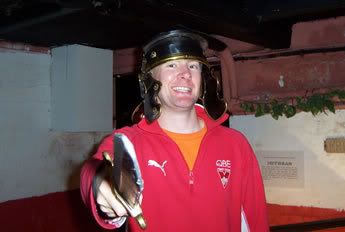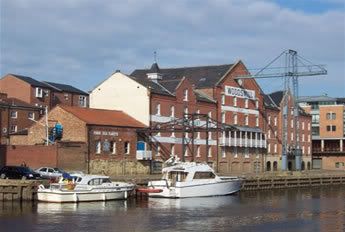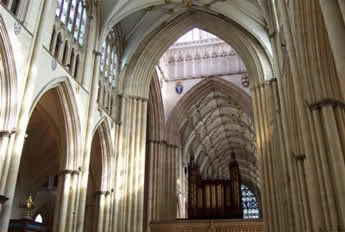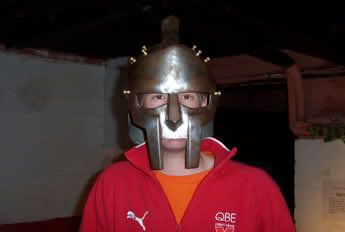
Hah! Take that ancient Briton! Us fearless Romans are one of the most formidable fighting machines in history! Cower from this well-drilled legionnaire as he skillfully swings his short sword. No, it isn't made of plastic. Chemically modified natural polymers won't be formed into rudimentary plastics until the nineteenth century! See we are an educated army also! And Caesar recently signed a sponsorship deal with the yet-to-be-invented clothing manufacturer Puma, yes. Have at thee, smartarse! Begone, lest I set my Gladiator brother on you!

This is where I've been all weekend, staying in one of these converted warehouses on the banks of the River Ouse in York. As you can see from the archive photo above this one, the city was founded by the ninth legion of the Roman Army in AD 71 and named 'Eboracum' - place of the yew trees. It grew to such a size, that in AD 237 it was proclaimed a 'Colonia', the equivalent to a city. In the 5th Century the Romans left Britain, as their vast empire was crumbling, and the region was conquered by the Anglian King Edwin. He renamed the city Eorforwic, as it seems he suffered from some kind of speech impediment.

The River Ouse on a misty morning. Contrary to the name, Ouze is a derivative of an early Saxon word meaning 'clear'. York sits on the confluence of two rivers, the Foss being the smaller of the two. This often means trouble, and the city frequently floods. In 2000, the river level rose 17ft higher than normal (the highest for over 350yrs), and this view was under water up to the tops of the first floor windows. But these pubs always clean up and re-open, it obviously comes with the territory.

There's history everywhere you turn in York, and it is one of the few walled cities left in the UK. Circling for about three miles, they are largely intact - albeit run down in a few places. The only major section without walls was in olden times defended by a large swampy bog called the 'King's Fishpond', that coupled the deterrent of a large stretch of water with the added obstacle of rotting carcasses the defenders dropped in. These days, the water has long since been drained, and if you do a full circuit of the walls you have to walk along a main road by Allied Carpets and a Majestic Wine warehouse, until you rejoin the ancient battlements and continue.

King Edwin was baptised in a small wooden structure near the centre of Eorforwic in AD 627. Almost 100 years later, York became an Archbishopric, and the first ever Archbishop of York was the delightfully named Ecgbert. However, the Normans destroyed early York and William installed Thomas of Bayeux as his Ab of Y. He started on a more substantial building, but it wasn't until 1220 that the 'modern' cathedral was begun. It took a staggering 250yrs to build, and was consecrated on the 3rd of July 1472, as builders were still sticking bits of battlement together. Today, much of it is restored (a massive fire razed a lot of it in 1984). But original features do remain, like the large East window (lower right of this pic)- at 76ft high and dating from the late 15th Century it's the largest example of medieval stained glass in the world. It was created before Columbus set off on his voyage to the New World.

Someone call for a Gladiator?